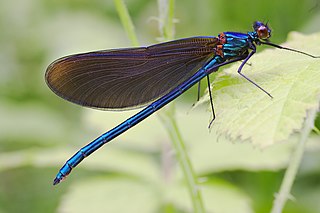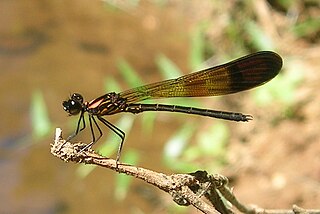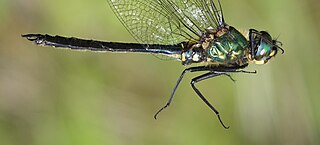
The Calopterygidae are a family of damselflies, in the suborder Zygoptera. They are commonly known as the broad-winged damselflies, demoiselles, or jewelwings. These rather large damselflies have wingspans of 50–80 mm, are often metallic-coloured, and can be differentiated from other damselflies by the broader connection between the wings and the body, as opposed to the abrupt narrowing seen in other damselfly families. The family contains some 150 species.

Calopteryx is a genus of large damselflies belonging to the family Calopterygidae. The colourful males often have coloured wings whereas the more muted females usually have clear wings although some develop male (androchrome) wing characteristics. In both sexes, there is no pterostigma.

Hetaerina is a genus of damselflies in the family Calopterygidae. They are commonly known as rubyspots because of the deep red wing bases of the males. The name is from Ancient Greek: ἑταίρα (hetaira), courtesan. H. rudis, the Guatemalan rubyspot, is considered vulnerable on the IUCN Red Data List.

Chlorocyphidae is a family of damselflies, commonly known as jewels. These are colorful species native to the Old World tropics, where they occur along forest streams. They are most diverse in Southeast Asia.

Euphaeidae, sometimes incorrectly named Epallagidae and commonly called gossamerwings, is a family of damselflies in the odonate superfamily Calopterygoidea. The family is small, consisting of around 78 species living species in nine genera occurring in the Palearctic, Australasia, and Asia. The family contains two subfamilies, Euphaeinae, encompassing all the living species and a single fossil genus, and the extinct Eodichromatinae, encompassing fossil genera from the Eocene to late Oligocene. Euphaeid species are large and mostly metallic-coloured, looking similar to species of damselflies in the family Calopterygidae.

The brilliant emerald, Somatochlora metallica, is a middle-sized species of dragonfly. It is the largest and greenest of the Somatochlora species; 50–55 millimetres (2.0–2.2 in) long.

Vestalis is a genus of damselflies belonging to the family Calopterygidae.

Vestalis gracilis, is a species of damselfly belonging to the family Calopterygidae. It is known commonly as the clear-winged forest glory or clear-winged flash-wing. It is native to Southeast Asia and surrounding regions.

Matrona is a genus of damselflies in the family Calopterygidae.

Vestalis apicalis, or the black-tipped forest glory, is a species of damselfly belonging to the family Calopterygidae. It is found in India and Sri Lanka.

Atrocalopteryx is a genus of damselflies belonging to the family Calopterygidae. It was established in 2005 during a phylogenetic study of the family, and its definition is still unclear.

Coeliccia is a genus of damselflies in the family Platycnemididae. They are distributed in Asia from India to Japan to Indonesia. It is the largest genus in the family, with around 80 species.

Vestalis submontana is a species of damselfly belonging to the family Calopterygidae. It is principally found in the Western Ghats of India, with some records further east.
Indocypha is a genus of jewel damselfly in the family Chlorocyphidae. There are about eight described species in Indocypha. The species was first spotted in Thailand.
Caliphaea is a genus of broad-winged damselflies in the family Calopterygidae. There are about five described species in Caliphaea.
2017 in paleoentomology is a list of new fossil insect taxa that were described during the year 2017, as well as other significant discoveries and events related to paleoentomology that were scheduled to occur during the year.

Somatochlora graeseri is a species of dragonfly in the family Corduliidae. It is found in Asia, where it occurs in Japan, Korea, northern China, and Russia.
Devadatta is a genus of damselflies in the family Devadattidae which is a sister-group of the Chlorocyphidae. There are about 13 described species in Devadatta.
This paleoentomology list records new fossil insect taxa that were to be described during the year 2021, as well as notes other significant paleoentomology discoveries and events which occurred during that year.













